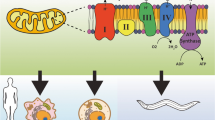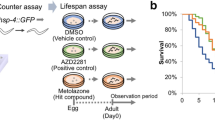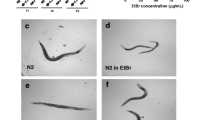Abstract
We previously showed that fluorizoline, a fluorinated thiazoline compound, binds to both subunits of the mitochondrial prohibitin (PHB) complex, PHB1 and PHB2, being the expression of these proteins required for fluorizoline-induced apoptosis in mouse embryonic fibroblasts. To investigate the conservation of this apoptotic mechanism, we studied the effect of PHB downregulation on fluorizoline activity on two human cell lines, HEK293T and U2OS. Then, we asked whether PHBs mediate the effect of fluorizoline in a multicellular organism. Interestingly, reduced levels of PHBs in the human cells impaired the induction of apoptosis by fluorizoline. We observed that fluorizoline has a detrimental dose-dependent effect on the development and survival of the nematode model Caenorhabditis elegans. Besides, such effects of fluorizoline treatment in living nematodes were absent in PHB mutants. Finally, we further explored the apoptotic pathway triggered by fluorizoline in human cell lines. We found that the BH3-only proteins NOXA, BIM and PUMA participate in fluorizoline-induced apoptosis and that the induction of NOXA and PUMA is dependent on PHB expression.







Similar content being viewed by others
References
Hanahan D, Weinberg RA (2011) Hallmarks of cancer: the next generation. Cell 144:646–674. https://doi.org/10.1016/j.cell.2011.02.013
Muller PAJ, Vousden KH (2013) P53 mutations in cancer. Nat Cell Biol 15:2–8
Pérez-Perarnau A, Preciado S, Palmeri CM et al (2014) A trifluorinated thiazoline scaffold leading to pro-apoptotic agents targeting prohibitins. Angew Chem Int Ed 53:10150–10154. https://doi.org/10.1002/anie.201405758
Pomares H, Palmeri CM, Iglesias-Serret D et al (2016) Targeting prohibitins induces apoptosis in acute myeloid leukemia cells. Oncotarget 7:64987–65000. https://doi.org/10.18632/oncotarget.11333
Cosialls AM, Pomares H, Iglesias-Serret D et al (2017) The prohibitin-binding compound fluorizoline induces apoptosis in chronic lymphocytic leukemia cells through the upregulation of NOXA and synergizes with ibrutinib, 5-aminoimidazole-4-carboxamide riboside or venetoclax. Haematologica 102:1587–1593. https://doi.org/10.3324/haematol.2016.162958
Wierz M, Pierson S, Chouha N et al (2018) The prohibitin-binding compound fluorizoline induces apoptosis in chronic lymphocytic leukemia cells ex vivo but fails to prevent leukemia development in a murine model. Haematologica 103:e154–e157
Moncunill-Massaguer C, Saura-Esteller J, Pérez-Perarnau A et al (2015) A novel prohibitin-binding compound induces the mitochondrial apoptotic pathway through NOXA and BIM upregulation. Oncotarget 6:41750–41765. https://doi.org/10.18632/oncotarget.6154
Wang D, Tabti R, Elderwish S et al (2020) Prohibitin ligands: a growing armamentarium to tackle cancers, osteoporosis, inflammatory, cardiac and neurological diseases. Cell Mol Life Sci. https://doi.org/10.1007/s00018-020-03475-1
Thuaud F, Ribeiro N, Nebigil CG, Désaubry L (2013) Prohibitin ligands in cell death and survival: mode of action and therapeutic potential. Chem Biol 20:316–331
Yang J, Li B, He QY (2018) Significance of prohibitin domain family in tumorigenesis and its implication in cancer diagnosis and treatment review-article. Cell Death Dis 9:580
Signorile A, Sgaramella G, Bellomo F, De Rasmo D (2019) Prohibitins: a critical role in mitochondrial functions and implication in diseases. Cells 8:71. https://doi.org/10.3390/cells8010071
Peng Y-T, Chen P, Ouyang R-Y, Song L (2015) Multifaceted role of prohibitin in cell survival and apoptosis. Apoptosis 20:1135–1149. https://doi.org/10.1007/s10495-015-1143-z
Wei Y, Chiang W-C, Sumpter R et al (2017) Prohibitin 2 is an inner mitochondrial membrane mitophagy receptor. Cell 168:224-238.e10. https://doi.org/10.1016/j.cell.2016.11.042
Hernando-Rodríguez B, Artal-Sanz M (2018) Mitochondrial quality control mechanisms and the PHB (Prohibitin). Complex Cells 7:238. https://doi.org/10.3390/cells7120238
Nijtmans LGJ, Artal Sanz M, Grivell LA, Coates PJ (2002) The mitochondrial PHB complex: roles in mitochondrial respiratory complex assembly, ageing and degenerative disease. Cell Mol Life Sci 59:143–155
Chowdhury I, Thompson WE, Welch C et al (2013) Prohibitin (PHB) inhibits apoptosis in rat granulosa cells (GCs) through the extracellular signal-regulated kinase 1/2 (ERK1/2) and the Bcl family of proteins. Apoptosis 18:1513–1525. https://doi.org/10.1007/s10495-013-0901-z
McClung JK, Danner DB, Stewart DA et al (1989) Isolation of a cDNA that hybrid selects antiproliferative mRNA from rat liver. Biochem Biophys Res Commun 164:1316–1322. https://doi.org/10.1016/0006-291X(89)91813-5
Liu P, Xu Y, Zhang W et al (2017) Prohibitin promotes androgen receptor activation in ER-positive breast cancer. Cell Cycle 16:776–784. https://doi.org/10.1080/15384101.2017.1295193
Cao Y, Liang H, Zhang F et al (2016) Prohibitin overexpression predicts poor prognosis and promotes cell proliferation and invasion through ERK pathway activation in gallbladder cancer. J Exp Clin Cancer Res. https://doi.org/10.1186/s13046-016-0346-7
Fu P, Yang Z, Bach LA (2013) Prohibitin-2 binding modulates insulin-like growth factor-binding protein-6 (IGFBP-6)-induced rhabdomyosarcoma cell migration. J Biol Chem 288:29890–29900. https://doi.org/10.1074/jbc.M113.510826
Chiu CF, Ho MY, Peng JM et al (2013) Raf activation by Ras and promotion of cellular metastasis require phosphorylation of prohibitin in the raft domain of the plasma membrane. Oncogene 32:777–787. https://doi.org/10.1038/onc.2012.86
Merkwirth C, Dargazanli S, Tatsuta T et al (2008) Prohibitins control cell proliferation and apoptosis by regulating OPA1-dependent cristae morphogenesis in mitochondria. Genes Dev 22:476–488. https://doi.org/10.1101/gad.460708
Sanz MA, Tsang WY, Willems EM et al (2003) The mitochondrial prohibitin complex is essential for embryonic viability and germline function in Caenorhabditis elegans. J Biol Chem 278:32091–32099. https://doi.org/10.1074/jbc.M304877200
Ran FA, Hsu PD, Wright J et al (2013) Genome engineering using the CRISPR-Cas9 system. Nat Protoc 8:2281–2308. https://doi.org/10.1038/nprot.2013.143
Brenner S (1974) The genetics of Caenorabditis elegans. Genetics. https://doi.org/10.1016/S0047-2484(78)80101-8
Porta-de-la-Riva M, Fontrodona L, Villanueva A, Cerón J (2012) Basic Caenorhabditis elegans methods: synchronization and observation. J Vis Exp. https://doi.org/10.3791/4019
Hernando-Rodríguez B, Erinjeri AP, Rodríguez-Palero MJ et al (2018) Combined flow cytometry and high-throughput image analysis for the study of essential genes in Caenorhabditis elegans. BMC Biol 16:36. https://doi.org/10.1186/s12915-018-0496-5
Artal-Sanz M, Tavernarakis N (2009) Prohibitin couples diapause signalling to mitochondrial metabolism during ageing in C. elegans. Nature 461:793–797. https://doi.org/10.1038/nature08466
Zubovych I, Doundoulakis T, Harran PG, Roth MG (2006) A missense mutation in Caenorhabditis elegans prohibitin 2 confers an atypical multidrug resistance. Proc Natl Acad Sci USA 103:15523–15528. https://doi.org/10.1073/pnas.0607338103
Zubovych IO, Straud S, Roth MG (2010) Mitochondrial dysfunction confers resistance to multiple drugs in Caenorhabditis elegans. Mol Biol Cell 21:956–969. https://doi.org/10.1091/mbc.E09-08-0673
Birkinshaw RW, Czabotar PE (2017) The BCL-2 family of proteins and mitochondrial outer membrane permeabilisation. Semin Cell Dev Biol 72:152–162
Acknowledgements
We thank the CERCA Program/Generalitat de Catalunya for their institutional support. We also thank the Scientific and Technological Centers of Bellvitge Campus at the University of Barcelona.
Funding
This work was supported by grants from the Agencia Estatal de Investigación (Ministerio de Ciencia e Innovación), European Regional Development Fund (ERDF), the European Research Council, the Junta de Andalucía and the Instituto de Salud Carlos III (ISCIII) (SAF2017-83178-R to J.G.; PID2019-107991RB-I00 to R.L.; ERC-2011-StG-281691 and C2A ID: 42571/Exp: 70806 to M.A-S; PI15-00895 to J.C.). J.S-E and I.S-V are recipients of research fellowships from the Ministerio de Ciencia e Innovación. S.N-V is recipient of a research fellowship from Universitat de Barcelona. MD.M-B was supported by the Plan de Empleo Juvenil (EJP09) from the Junta de Anadalucía. D.K has a FI AGAUR fellowship from Generalitat de Catalunya.
Author information
Authors and Affiliations
Contributions
Conceptualization, JS-E, JC, MA-S, GP, DI-S and JG; Funding acquisition, RL, JC, MA-S and JG; Investigation, JS-E, JJ-C, DK, MDM-B and GP; Resources, LM-T and RL; Supervision, JG; Writing—original draft, JS-E, JC, MA-S, DI-S and JG; Writing—review & editing, IS-V, SN-V, JJ-C, AMC, LM-T, DK, MDM-B, RL and GP.
Corresponding author
Ethics declarations
Conflict of interest
The authors declare no conflict of interest.
Additional information
Publisher’s Note
Springer Nature remains neutral with regard to jurisdictional claims in published maps and institutional affiliations.
Daniel Iglesias-Serret and Joan Gil shares senior co-authorship.
Supplementary Information
Below is the link to the electronic supplementary material.
Rights and permissions
About this article
Cite this article
Saura-Esteller, J., Sánchez-Vera, I., Núñez-Vázquez, S. et al. Fluorizoline-induced apoptosis requires prohibitins in nematodes and human cells. Apoptosis 26, 83–95 (2021). https://doi.org/10.1007/s10495-020-01651-z
Accepted:
Published:
Issue Date:
DOI: https://doi.org/10.1007/s10495-020-01651-z




